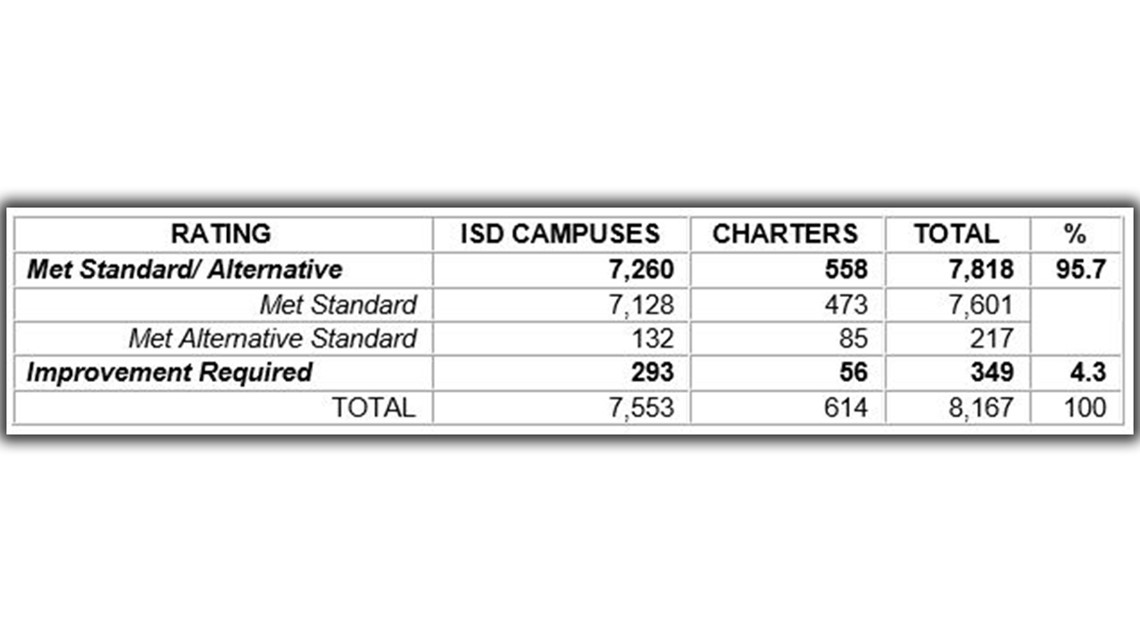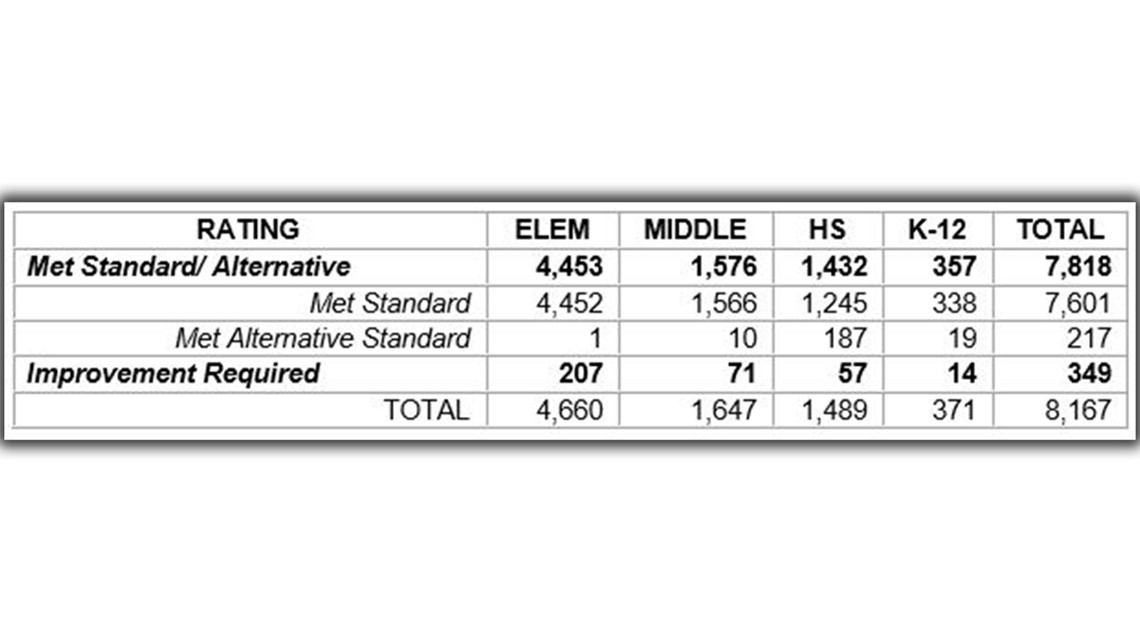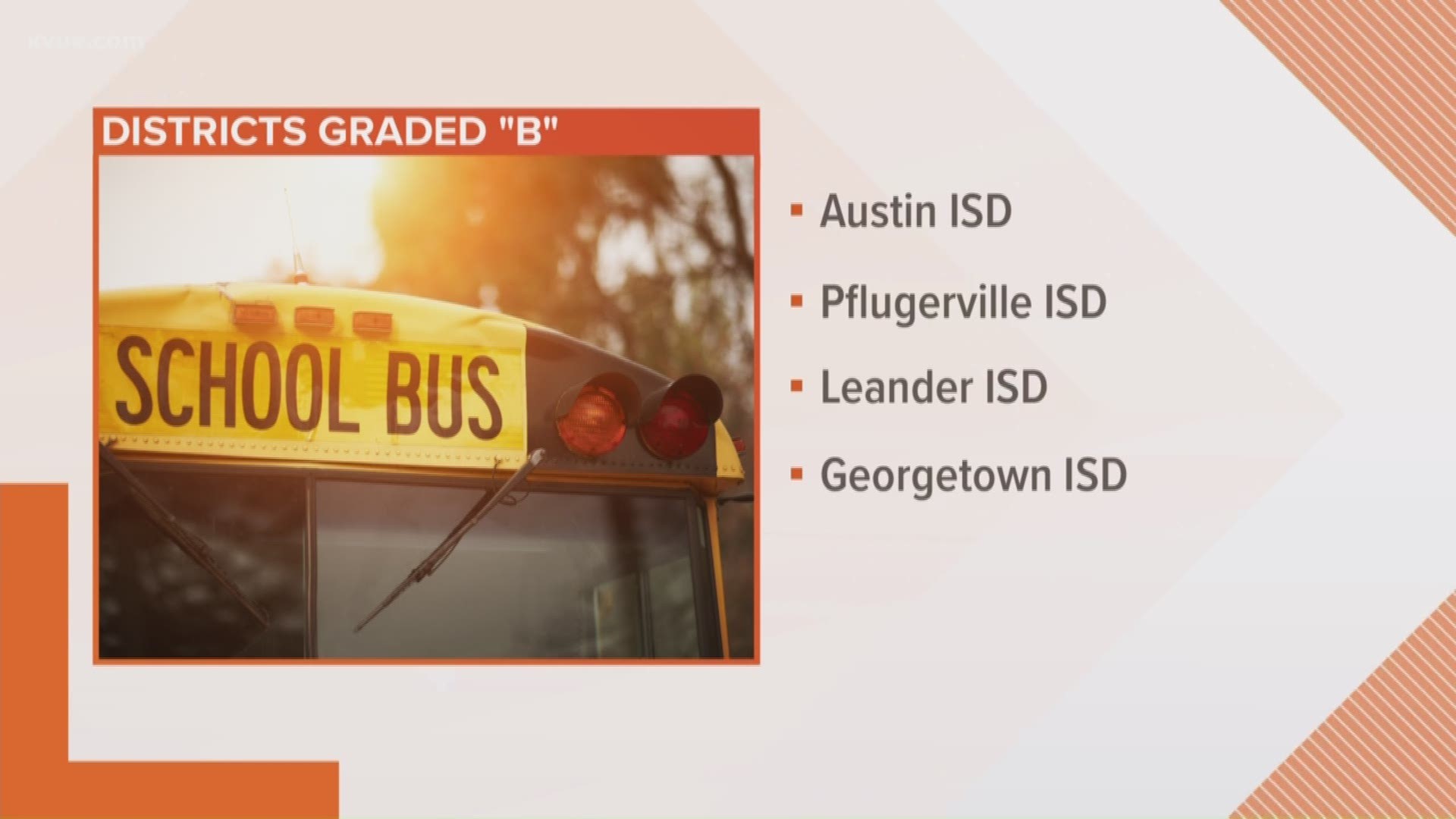AUSTIN — Summer vacation has come and gone, and now it's time for Texas kids to head back to class. While it may be six weeks or so before parents see how well their little ones are doing in school, parents are learning Wednesday that several campuses within Austin-area school districts failed to meet Texas academic standards under the state's new letter grade accountability system.
Austin Independent School District earned a B with an overall score of 89. However, Austin's school district had five failing schools. Widen Elementary School, Sadler Means Young Women’s Leadership Academy, Mendez Middle School and two alternative campuses -- the Graduation Prep Academy housed at Travis High School and the Rosedale School -- all failed to meet state standards. Rosedale School educates students with severe special needs, including significant disabilities and those who are medically fragile.
The district will appeal Rosedale's rating, saying they believe the campus should not receive a rating because fo the students it serves, according to KVUE's media partners at the Austin American-Statesman. In previous years, the state has either not rated the campus or the district won its appeal for a low ranking, the Statesman said.
Round Rock's school district received an A, Pflugerville Independent School District received a B and the TEA gave Leander's school district a B. Georgetown Independent School District received a B, and Hays Consolidated Independent School District, Bastrop, Lockhart and Hutto earned a C. Eanes Independent School District and Lake Travis Independent School District both earned an A. Manor Independent School District and Del Valle Independent School District were given a D.
The Texas Education Agency released A through F rankings for school districts and 0 to 100 rankings for campuses. Go here to find out where your child's school and school district stands.
"Hopefully it's a system that's easy to understand, that, you know, here's where my child's school's doing well; here's some areas where maybe assistance is needed," said Lauren Callahan, spokesperson for the Texas Education Agency.
While the grades themselves may be easy to understand, getting to this point hasn't exactly been easy.
"The legislature in 2015 instructed the Commissioner in a bill to issue letter grade ratings for districts and campuses," Callahan explained.
At the start of the 2017 legislative session, the Texas Education Agency gave lawmakers a "what if" report detailing what grades districts would get if the 2015 bill was already in effect. And things quickly became political.
Lt. Gov. Dan Patrick (R) used the rankings to push for education savings accounts; also known as "school choice" or "school vouchers," depending on what side of the issue you're on.
"Talking about his ideas about school choice and about private school funding for students to be able to pay for private school with state money," said Aliyyah Swaby, the public education reporter for The Texas Tribune. "And talking about how if a school is a D or an F, a parent should be able to use that funding to attend a different school."
Many school leaders were unhappy with rankings and the way they're calculated. So during the 2017 session, lawmakers made some changes to the original bill.
Now the rankings are calculated based on scores in three areas or domains; student achievement, school progress and closing the gaps.
Student achievement is calculated based on how much students know and how well they do in tested subjects. For students in elementary and middle school, this is solely based on STAAR test scores. In high school, other performance measures, including SAT and ACT tests, AP scores and college and career readiness are also taken into account.
School Progress is a comparison of how students perform compared to the previous year on STAAR tests and how they compare to students at similar schools.
Closing the Gaps divides students into groups based on race, income level and special education status then determines a score based on how well the students in each group are doing in terms of academic growth and student achievement compared to other students.
Once there are scores in all three areas, the top score out of the student achievement and school progress rankings accounts for 70 percent of the overall grade. The Closing the Gap score makes up the remaining 30 percent.
"For several years now we've been on basically a pass-fail system," said Callahan. "But you really didn't have a great insight into really the strengths of that campus or district and really where their improvement was needed in some regard. This system is hopefully going to provide a lot of clarity behind, we're doing these things well and we need to help our students in these areas."
But that also means in the 2019 legislative session we'll likely hear more about the district grades and funding schools.
"Last session, school choice and school finance sort of butted up against each other," said Swaby. "It wasn't going to be possible to pass anything major in terms of school finance without also passing something in terms of school choice So, you know, I think that conversation and that debate is definitely gong to continue to happen. And I think the accountability system definitely plays a roll in that."
Ken Zarifis is the president of Education Austin, the employees union for AISD. He said this new setup only strengthens a system focused on testing rather than teaching.
"The system we have now forces systems and classes to teach to a test because it's so punitive," Zarifis said. "We care more about the punishment than we do about the kids. And that's not because teachers believe that. That's because the state has forced that upon us."
Zarifis also said legislature needs to put its efforts towards investing in public education.
"They say you have to do more with less, and I'm here to tell you, you only do less with less," Zarifis said. "You don't do more. When the emphasis is on testing, you need a result. And the result is a number that occupies an Excel spreadsheet cell. Our kids -- my own children -- are more than that test. That's why I opt them out of testing. They are more than a test score."
Zarifis said the people making the decisions for all the Texas school districts are out of touch with how schools are run today.
"The easiest way to blame a school is to be able to put a single letter on a school and say, 'They're not doing it,'" Zarifis said. "The people who are advisors have probably spent no time in the classroom. They don't know what teaching is about. Really, they're so far removed from learning, they don't know even know what learning is about in 2018."
In addition to the A-F grades, campuses were also given one of three ratings under the accountability system: Met Standard, Met Alternative Standard, or Improvement Required. The A-F grades will be applied to campuses at the end of the upcoming school year.
Campus ratings in 2018 are below:


Campus ratings by category and school type:


According to the TEA, 86 campuses would have received an Improvement Required rating but met at least one of the Hurricane Harvey criteria announced in June. Those campuses were labeled Not Rated: Harvey Provision. The years 2017 and 2019 will be considered consecutive for school districts, open-enrollment charter schools and campuses receiving this label due to Harvey-related issues.
A list of other Not Rated campuses (506) for reasons other than Harvey can be found here.

